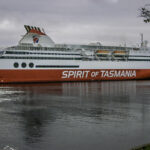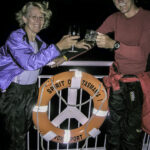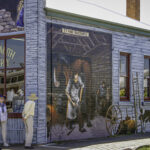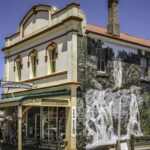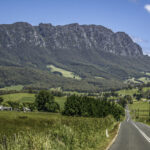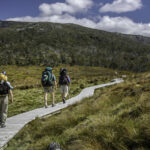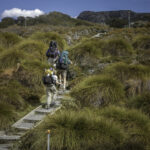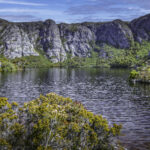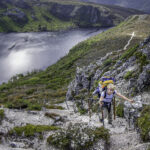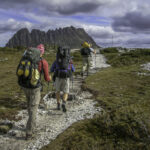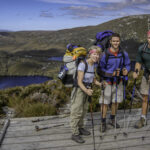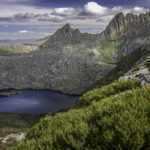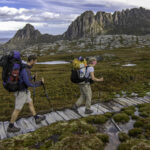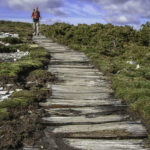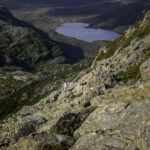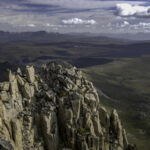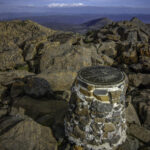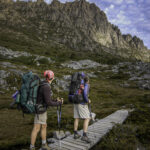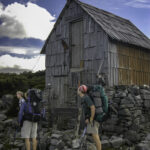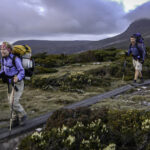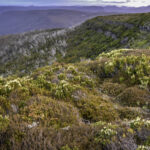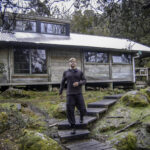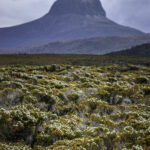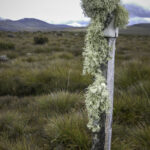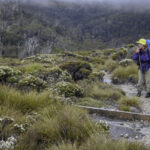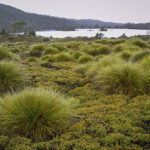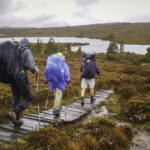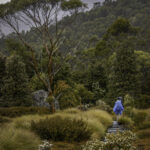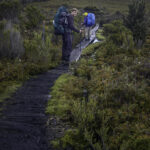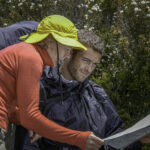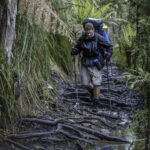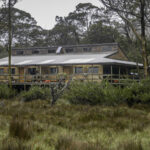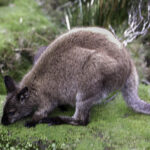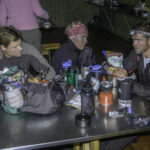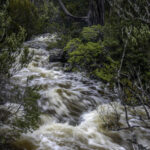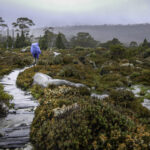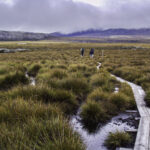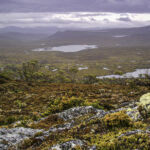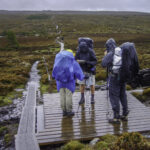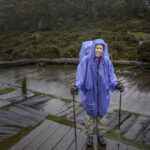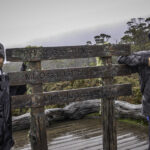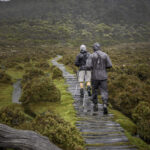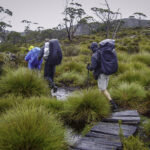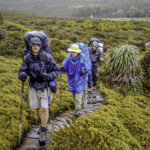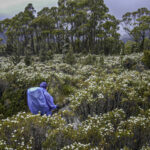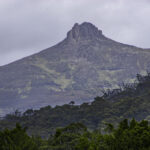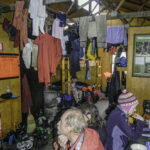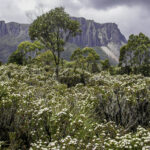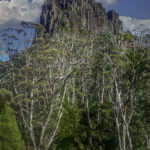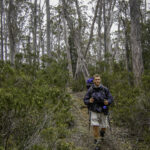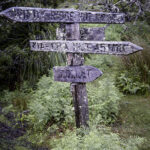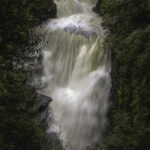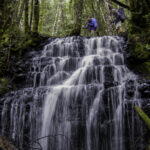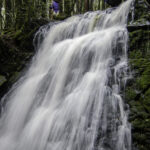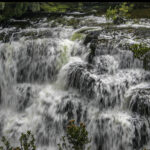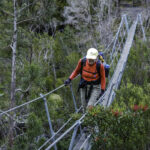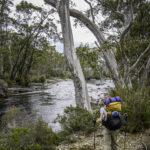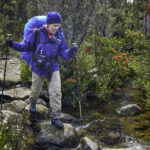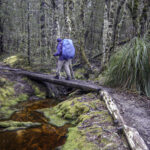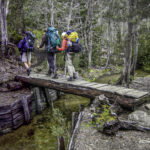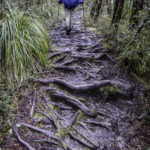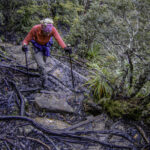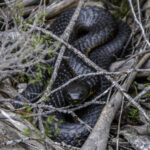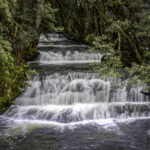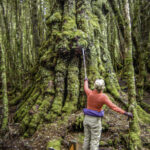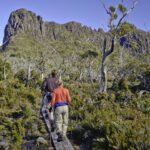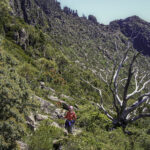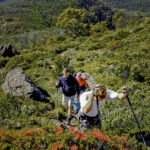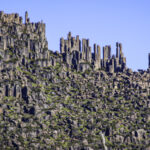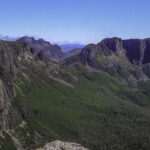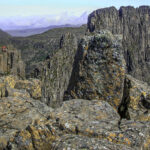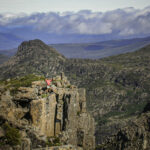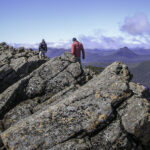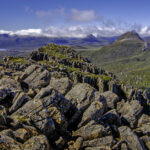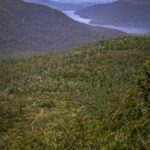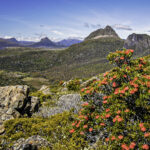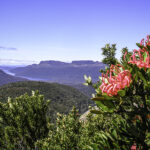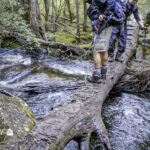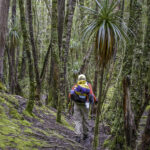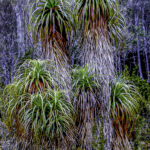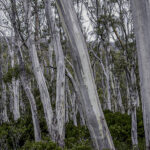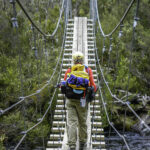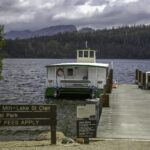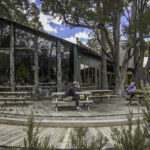
After returning from our day at Bells Beach, we made our way to the ferry terminal in Melbourne, ready to embark on the next leg of our adventure—Tasmania. It had been nearly 50 years since our last visit in 1975, and this time we were returning with our adult children, Kevin and Eric. The nostalgia was strong, but this trip felt fresh and exciting. Back in 1975, we slept on the deck of the ferry under the stars, but this time, we treated ourselves to a state room for a bit more comfort.
We boarded the Spirit of Tasmania, the ferry that crosses the Bass Strait, a stretch of water known for its unpredictable weather and strong currents. The ferry journey is about 9 to 11 hours, depending on conditions, and it’s the primary route for travelers heading from mainland Australia to Tasmania. The Bass Strait separates Tasmania from Victoria, and while the crossing can be rough at times, the ferry is well-equipped with lounges, dining areas, and cabins. After a full day, we were glad to settle into our state room and get some rest before the next day’s adventures.
We woke up the next morning to the sight of Launceston, Tasmania’s second-largest city, coming into view. The ferry docked smoothly, and after disembarking, we arranged for transport to take us to the trailhead at Cradle Mountain, where we would begin our hike along the famous Overland Track.
Before heading to the trailhead for our hike on the Overland Track, we had a bit of time to explore Launceston. As one of Tasmania’s oldest cities, Launceston is full of history and charm. It was established in 1806 and is known for its well-preserved colonial and Victorian architecture. Walking through the streets felt like stepping back in time, with beautiful heritage buildings and leafy parks everywhere we turned.
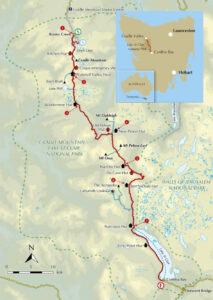 After the quick tour, we set off towards Cradle Mountain, stopping at a few quaint towns along the way to savor some of Tasmania’s local dishes. Knowing we’d be eating camp food for the next six days on the trail, we treated ourselves to some indulgent meals, sampling fresh Tasmanian seafood, local cheeses, and even a bit of their famous beef. The warmth of the local cafés and the charm of these small spots made the journey feel unhurried, even as the anticipation of the trek ahead grew.
After the quick tour, we set off towards Cradle Mountain, stopping at a few quaint towns along the way to savor some of Tasmania’s local dishes. Knowing we’d be eating camp food for the next six days on the trail, we treated ourselves to some indulgent meals, sampling fresh Tasmanian seafood, local cheeses, and even a bit of their famous beef. The warmth of the local cafés and the charm of these small spots made the journey feel unhurried, even as the anticipation of the trek ahead grew.
As we approached Cradle Mountain-Lake St. Clair National Park, the weather couldn’t have been more perfect. The sun shone brightly, lighting up the surrounding mountains and valleys. When we finally reached the Dove Lake viewpoint, the scene took our breath away. Cradle Mountain, with its jagged peaks, reflected perfectly in the still waters of the lake. It was a view we knew we’d never forget—an unforgettable introduction to the wilderness we were about to spend the next several days hiking through.
With full stomachs and our spirits high, we headed to the trailhead, ready for the adventure of a lifetime. Click on thumbnail to view images
Day 1 Hike from Cradle Mountain trailhead to Barn Bluff Hut
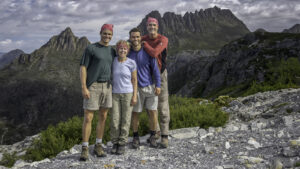 The Overland Track is one of Australia’s most iconic hiking trails, stretching 65 kilometers (40 miles) from Cradle Mountain to Lake St. Clair through the heart of Tasmania’s Wilderness World Heritage Area. It’s a challenging yet incredibly rewarding trek, taking hikers through rugged mountains, ancient rainforests, alpine plains, and glacially-carved valleys. The track typically takes six days to complete, and it’s well-marked but remote, with hikers carrying all their gear, food, and supplies. Each day offers new landscapes, with highlights like Cradle Mountain, Barn Bluff, Pelion Gap, and the beautiful D’Alton and Ferguson Falls.
The Overland Track is one of Australia’s most iconic hiking trails, stretching 65 kilometers (40 miles) from Cradle Mountain to Lake St. Clair through the heart of Tasmania’s Wilderness World Heritage Area. It’s a challenging yet incredibly rewarding trek, taking hikers through rugged mountains, ancient rainforests, alpine plains, and glacially-carved valleys. The track typically takes six days to complete, and it’s well-marked but remote, with hikers carrying all their gear, food, and supplies. Each day offers new landscapes, with highlights like Cradle Mountain, Barn Bluff, Pelion Gap, and the beautiful D’Alton and Ferguson Falls.
This time, experiencing it with Kevin and Eric made it even more special. The boys were excited to take on the trail, and we were eager to relive the adventure of exploring Tasmania’s wild beauty—now, as a family. After reaching Cradle Mountain, we stood together at the start of the trail, ready to take our first steps on this incredible journey.
We arrived at the Overland Track trailhead just around noon. The excitement was contagious as we laced up our boots and took in the expansive views around us. Much has changed since our first trek in 1975; the trail has been significantly improved with well-maintained boardwalks over delicate areas, making the journey more accessible and protecting the fragile landscape.
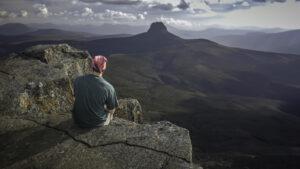 Our first big objective was Cradle Mountain, the iconic, rugged peak that marks the beginning of this epic trail. Standing at 1,545 meters (5,069 feet), Cradle Mountain is one of Tasmania’s most beloved landmarks, offering challenging climbs and sweeping views of the wilderness below. The ascent was exhilarating, and the higher we climbed, the more the scenery unfolded. Once at the summit, we were treated to a stunning panorama of the surrounding national park, with the impressive shape of Barn Bluff visible in the distance. The views were expansive and humbling, reminding us of the wild beauty that Tasmania holds.
Our first big objective was Cradle Mountain, the iconic, rugged peak that marks the beginning of this epic trail. Standing at 1,545 meters (5,069 feet), Cradle Mountain is one of Tasmania’s most beloved landmarks, offering challenging climbs and sweeping views of the wilderness below. The ascent was exhilarating, and the higher we climbed, the more the scenery unfolded. Once at the summit, we were treated to a stunning panorama of the surrounding national park, with the impressive shape of Barn Bluff visible in the distance. The views were expansive and humbling, reminding us of the wild beauty that Tasmania holds.
After taking it all in, we descended from Cradle Mountain to rejoin the main trail. The landscape changed around us as we made our way through alpine plains and rugged forest, slowly closing the distance to Barn Bluff. This towering dolerite mountain, rising 1,559 meters (5,115 feet) above sea level, is one of the most photographed peaks on the Overland Track, known for its dramatic, layered appearance that’s especially striking in the early morning or evening light.
We reached our first hut in the shadow of Barn Bluff just before dusk, ready to set up camp. With our gear stowed and a delicious camp dinner on the go, we sat together, soaking up the quiet of the wilderness and recounting the day’s highlights. It’s amazing how a meal tastes that much better under an open sky after a rewarding day on the trail. Click on thumbnail to view images
Day 2 Hike from Barn Bluff Hut to Windermere Hut
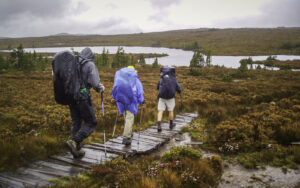 The next morning, we were up early, energized by the crisp air and the day’s promise of new terrain. The skies looked ominous, and rain seemed inevitable, but we pulled on our rain gear and hit the trail. Today’s path would take us through the iconic Buttongrass Plains—a landscape unique to Tasmania and well known among Overland Track hikers. Buttongrass is a resilient sedge, with tufts that dot the landscape and thrive in Tasmania’s often wet conditions. It’s a deceptively hardy plant and a cornerstone of the region’s ecosystem, its roots helping to drain excess water and create those characteristic, slightly bouncy mounds.
The next morning, we were up early, energized by the crisp air and the day’s promise of new terrain. The skies looked ominous, and rain seemed inevitable, but we pulled on our rain gear and hit the trail. Today’s path would take us through the iconic Buttongrass Plains—a landscape unique to Tasmania and well known among Overland Track hikers. Buttongrass is a resilient sedge, with tufts that dot the landscape and thrive in Tasmania’s often wet conditions. It’s a deceptively hardy plant and a cornerstone of the region’s ecosystem, its roots helping to drain excess water and create those characteristic, slightly bouncy mounds.
During our last hike here in the 70s, the trail was far more rugged, requiring us to leap from one tuft of buttongrass to another to avoid sinking into the water that collects in the boggy ground below. Today, we were thankful for the boardwalks that cut through much of the area, saving our energy and keeping our feet drier as we crossed the wide, open plains. The rain steadily worsened, creating a mist that clung to the plains and gave everything an ethereal look, but our spirits stayed high, spurred by the adventure and the memories of our first trek.
We passed several beautiful, reflective lakes along the way, their surfaces dotted with raindrops, which only added to the remote, otherworldly feel of the journey. Eventually, the trail led us into a more forested area, and while we were glad for the shelter, we found ourselves navigating around the exposed roots that jutted up along the path. Each step required a bit of care to avoid tripping, especially with the wet and slippery conditions, but the trees were a welcome change from the wide-open plains, offering a cozy enclosure as we approached Windermere Hut.
Arriving at Windermere was a relief. Nestled by Lake Windermere, the hut provides a rustic yet inviting shelter for hikers needing a break from the elements. We hung up our rain-soaked gear and settled in, warmed by a hearty camp dinner and the camaraderie of other hikers who had gathered to dry off and swap stories. Click on thumbnail to view images
Day 3 Hike Lake Windermere Hut to Pelion Hut
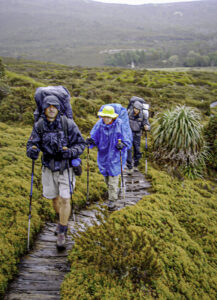 Another day, another early start, though the rain showed no signs of letting up. We bundled up in our rain gear and set off, ready to tackle the trail despite the drizzle. The plan for today was to reach Old Pelion Hut, a place steeped in the history of Tasmania’s early wilderness exploration. Along the way, we’d pass Mt. Ossa, Tasmania’s tallest peak and one of the highlights of the Overland Track.
Another day, another early start, though the rain showed no signs of letting up. We bundled up in our rain gear and set off, ready to tackle the trail despite the drizzle. The plan for today was to reach Old Pelion Hut, a place steeped in the history of Tasmania’s early wilderness exploration. Along the way, we’d pass Mt. Ossa, Tasmania’s tallest peak and one of the highlights of the Overland Track.
Mt. Ossa rises to 1,617 meters (5,305 feet), offering stunning 360-degree views of the surrounding mountains on a clear day. The peak holds special significance, with its sheer dolerite cliffs and a sense of vast, untouched wilderness that is rare even in Tasmania. Kevin and Eric were especially excited to tackle the summit, despite the low visibility and challenging conditions. We watched them set off on the steep, rocky path leading up to the peak, undeterred by the rain. After a few hours, they rejoined us on the main trail, exhilarated from their climb even if they had to imagine the sweeping views from the top.
As we continued toward Pelion Hut, the trail led us through yet another stretch of button grass plains before merging into denser foliage. Button grass has been a feature of every day on the trail so far, and even in the rain, its spiky tufts held a rugged beauty, marking the landscape with its resilience. Moving into the denser forest brought a welcome change, but the rain meant navigating slippery roots and rocks, keeping us on our toes.
Finally, we arrived at Old Pelion Hut. Built in the late 1800s as a base for copper miners, the hut is a piece of Tasmanian history, preserved as a refuge for weary hikers. It’s a cozy, rustic shelter where you can almost feel the echoes of miners from a century ago. Gathering around with the other trekkers, we enjoyed the shelter and warmth that only Pelion Hut could provide, grateful for the break from the rain. Click on thumbnail to view images
Day 4 Hike from Pilion Hut to Kia Ora Hut
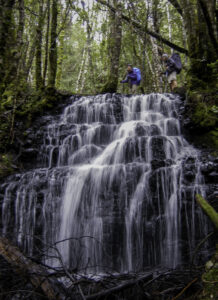 Waking to a hint of blue sky peeking through the clouds was a welcome sight after days of rain. Spirits high, we set off toward Kia Ora Hut, our next stop on the Overland Track. The improved weather felt like a gift, especially since we planned a side trip to explore some of Tasmania’s most stunning waterfalls along the Mersey River.
Waking to a hint of blue sky peeking through the clouds was a welcome sight after days of rain. Spirits high, we set off toward Kia Ora Hut, our next stop on the Overland Track. The improved weather felt like a gift, especially since we planned a side trip to explore some of Tasmania’s most stunning waterfalls along the Mersey River.
Kia Ora Hut is known as one of the more scenic huts on the trail, tucked in among eucalyptus trees with impressive views of the mountains and valleys nearby. But before reaching our destination, we made a detour to see D’Alton, Fergusson, and Hartnett Falls—three of the Overland Track’s most famous waterfalls, each unique in its beauty.
Our first stop was D’Alton Falls, where the Mersey River cascades over a sheer rock face into a deep, lush gorge. The recent rains had only made the falls more powerful, sending up a mist that glistened in the sunlight. Not far downstream is Fergusson Falls, another dramatic sight where water tumbles over a rugged ledge into the rainforest below. We couldn’t resist lingering here, soaking in the raw, untamed beauty that surrounded us. Our final waterfall, Hartnett Falls, was the largest of the three, with a wide, thunderous drop that created a spectacle as it crashed into the rocks below. Named after one of the early pioneers of the Overland Track, Hartnett Falls has become a must-see for hikers, and we could see why—it felt as if we were standing in the heart of Tasmanian wilderness.
Content with our detour, we continued along the trail toward Kia Ora Hut. The improved weather made for a pleasant hike, and by the time we arrived, we were grateful to be warm and dry. It was wonderful to sit back and take in the mountain views, which felt extra special after days of rain. Click on thumbnail to view images
Day 5 Hike from Kia Ora Hut to Pine Valley Hut
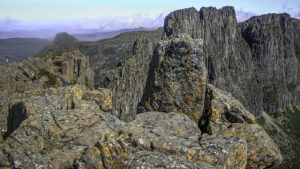 Our second to last day on the Overland Track was reserved for an ambitious side trip to The Acropolis—an imposing peak that’s considered one of the most iconic climbs in the Du Cane Range. Rising to 1,471 meters (4,826 feet), The Acropolis is famous for its sheer dolerite columns and panoramic views of Tasmania’s rugged landscape. The extra effort would be worth it, especially with the perfect weather.
Our second to last day on the Overland Track was reserved for an ambitious side trip to The Acropolis—an imposing peak that’s considered one of the most iconic climbs in the Du Cane Range. Rising to 1,471 meters (4,826 feet), The Acropolis is famous for its sheer dolerite columns and panoramic views of Tasmania’s rugged landscape. The extra effort would be worth it, especially with the perfect weather.
The trail leading to The Acropolis was rocky and challenging at first, demanding careful footing as we wound our way through the dense bushland. As we neared the mountain, the trail flattened, giving us a chance to catch our breath and appreciate the wild beauty around us. The final ascent was nothing short of exhilarating, with jagged rocks and steep scrambles that added a thrill to the journey.
Once at the summit, we were spellbound by the breathtaking views stretching across the Du Cane Range. The sheer cliffs, dramatic rock faces, and jagged formations of the surrounding peaks made us feel like we were standing at the top of the world. Off in the distance, we caught sight of Lake St Clair—our final destination and the southern endpoint of the Overland Track. It was incredible to think that after days of hiking, the finish line was in view.
We spent several hours on top, basking in the sweeping panoramas and the feeling of accomplishment before heading back down and onto the Pine Valley Hut for the nite. Click on thumbnail to view images
Day 6 Hike from Pine Valley Hut to Lake St Claire
On our final morning on the Overland Track, we took our time, savoring a leisurely breakfast before heading for Lake St Clair, where a ferry would carry us to the trail’s end. Lake St Clair, Australia’s deepest freshwater lake, stretches over 17 kilometers and lies at the southern end of Cradle Mountain–Lake St Clair National Park. It’s a stunning waterway, carved by glaciers and surrounded by ancient forests and towering peaks.
The path to the lake was lush and green, winding through ferns and moss-covered trees with several scenic creek crossings. One of the highlights was passing through a grove of Tasmanian ghost gums, their pale trunks contrasting beautifully with the deep greens of the forest around us.
When we reached the lake, our timing was perfect—the ferry was there, ready to take us across the water. The ferry trip down Lake St Clair was a peaceful experience, allowing us to relax and take in the landscape we had just trekked across. The mountains surrounding the lake seemed even more majestic from the water, and the journey felt like a fitting conclusion to our hike.
Our final stop was Lake St Clair Lodge, a comfortable retreat near the water’s edge where we rewarded ourselves with a hearty meal. Every bite felt earned after days of hiking and trail meals! Sitting by the lake with a full plate in front of us and the mountains behind, we felt a sense of accomplishment and gratitude for the incredible journey. It was the perfect end to our time on the Overland Track, and a memory we’d carry with us long after we left Tasmania.


